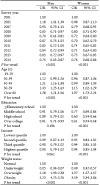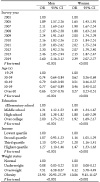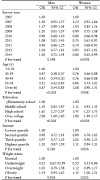Abstract
Background
The objective of study was to investigate secular trends for body-shape perception, weight-loss efforts, and weight-loss behaviors from 2001 to 2014 in Korean adults and factors related to those weight-related attitude.
Methods
Self-reported body-shape perception, weight-loss efforts, and weight-loss behaviors were used in 26,480 men and 35,051 women aged 19 or older using the Korean National Health and Nutrition Survey from 2001 to 2014 (from 2005 to 2014 for weight-loss behaviors). Multivariable logistic regression analysis was conducted using complex sampling design in each sex.
Results
Body-shape misperception tended to decrease from 2001 to 2014 and weight-loss efforts tended to increase over the period in all subjects, whereas unhealthy weight-loss behaviors tended to increase over the period in women. In multivariable logistic regression model, body-shape misperception in men was inversely associated with survey year, while positively associated with age and weight status. In women, body-shape misperception was inversely associated with survey year, education, and income, while positively associated with age and weight status. Weight-loss efforts in both sexes were inversely associated with age, while positively associated with survey year, education, income, and weight status. Healthy weight-loss behaviors were positively associated with education but inversely associated with age in men. In women, those behaviors were positively associated with education and weight status, while inversely associated with survey year.
Figures and Tables
References
1. Jee SH, Sull JW, Park J, Lee SY, Ohrr H, Guallar E, et al. Body-mass index and mortality in Korean men and women. N Engl J Med. 2006; 355(8):779–787.

2. World Health Organization. The challenge of obesity in the WHO European region and the strategies for response. 1st ed. Copenhagen: WHO regional office for Europe;2007. p. 1–23.
3. Jee SH, Yun JE, Park EJ, Cho ER, Park IS, Sull JW, et al. Body mass index and cancer risk in Korean men and women. Int J Cancer. 2008; 123(8):1892–1896.

4. Roh L, Braun J, Chiolero A, Bopp M, Rohrmann S, Faeh D, et al. Mortality risk associated with underweight: a census-linked cohort of 31,578 individuals with up to 32 years of follow-up. BMC Public Health. 2014; 14:371.

5. Hannan MT, Felson DT, Dawson-Hughes B, Tucker KL, Cupples LA, Wilson PW, et al. Risk factors for longitudinal bone loss in elderly men and women: the Framingham osteoporosis study. J Bone Miner Res. 2000; 15(4):710–720.

6. Suastika K, Dwipayana P, Saraswati MR, Gotera W, Budhiarta AA, Sutanegara ND, et al. Underweight is an important risk factor for coronary heart disease in the population of Ceningan Island, Bali. Diab Vasc Dis Res. 2012; 9(1):75–77.

7. Lusky A, Barell V, Lubin F, Kaplan G, Layani V, Shohat Z, et al. Relationship between morbidity and extreme values of body mass index in adolescents. Int J Epidemiol. 1996; 25(4):829–834.

8. Hoque ME, Mannan M, Long KZ, Al Mamun A. Economic burden of underweight and overweight among adults in the Asia-Pacific region: a systematic review. Trop Med Int Health. 2016; 21(4):458–469.

9. Lehnert T, Sonntag D, Konnopka A, Riedel-Heller S, König HH. Economic costs of overweight and obesity. Best Pract Res Clin Endocrinol Metab. 2013; 27(2):105–115.

10. Ahn BC, Joung H. Socioeconomic cost of obesity in Korea. Korean J Nutr. 2005; 38(9):786–792.
11. Arroyo-Johnson C, Mincey KD. Obesity epidemiology worldwide. Gastroenterol Clin North Am. 2016; 45(4):571–579.

12. Sallis JF, Glanz K. Physical activity and food environments: solution to the obesity epidemic. Milbank Q. 2009; 87(1):123–154.
13. Ministry of Health and Welfare. The results of the Sixth Korean National Health and Nutrition Examination Survey [Internet]. Sejong: Ministry of Health and Welfare;2015. Accessed Mar 8, 2017. Available from: http://www.mohw.go.kr/front_new/al/sal0301vw.jsp?PAR_MENU_ID=04&MENU_ID=0403&page=1&CONT_SEQ=326126&SEARCHKEY=TITLE&SEARCHVALUE=.
14. Korea Centers for Disease Control and Prevention. Korean health statistics 2001-2014: Korean National Health and Nutrition Examination Survey (KNHANES II~V-2) [Internet]. Cheongju: Korea Centers for Disease Control and Prevention;2017. Accessed Mar 8, 2017. Available from: https://knhanes.cdc.go.kr/knhanes/index.do.
15. Kim S, So WY. Secular trends in the prevalence of weight misperception among Korean adults, 2001-2013. Obes Res Clin Pract. 2016; 06. 14. pii: S1871-403X(16)30030-8. [Epub ahead of print].

16. Korea Centers for Disease Control and Prevention. The guide book from the Second to Sixth Korean National Health and Nutrition Examination Survey (KNHANES II~V-2) [Internet]. Cheongju: Korea Centers for Disease Control and Prevention;2015. Accessed Mar 8, 2017. Available from: https://knhanes.cdc.go.kr/knhanes/index.do.
17. Shin A, Nam CM. Weight perception and its association with socio-demographic and health-related factors among Korean adolescents. BMC Public Health. 2015; 15:1292.

18. Seo J, Ma HS, Kim SH, Kim JY, Shin MS, Yang YJ. Effects of the difference between actual body condition and body image perception on nutrient intake, weight control and mental health in Korean adults: based on the 5th Korea National Health and Nutrition Examination Survey. J Nutr Health. 2016; 49(3):153–164.

19. Joh HK, Oh J, Lee HJ, Kawachi I. Gender and socioeconomic status in relation to weight perception and weight control behavior in Korean adults. Obes Facts. 2013; 6(1):17–27.

20. Johnson-Taylor WL, Fisher RA, Hubbard VS, Starke-Reed P, Eggers PS. The change in weight perception of weight status among the overweight: comparison of NHANES III (1988-1994) and 1999-2004 NHANES. Int J Behav Nutr Phys Act. 2008; 5:9.





 PDF
PDF ePub
ePub Citation
Citation Print
Print







 XML Download
XML Download